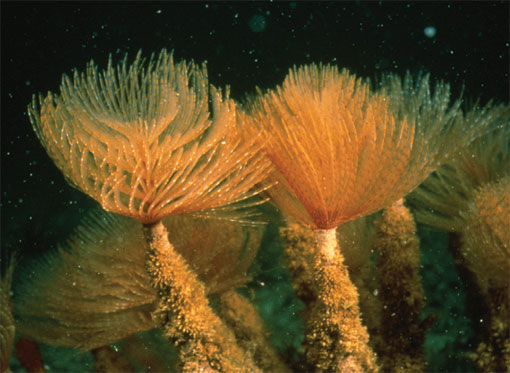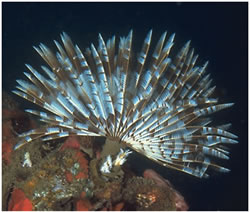
Feather-duster worm / Banded fan worm / Southern fan worm
Sabellastarte australiensis Key features:
- Feeding tentacles not spiralled, up to 15cm diameter
- Banded white and purple/brown
Habitat:
- Exposed rocky reefs up to 30m depth
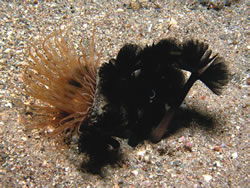
Anemone horseshoe wormPhoronis australis
Key features:
- Velvet black colour, tube length up to 20cm
Habitat:
- Silty/sandy sheltered areas, up to 30m depth
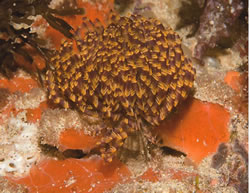
Sabellastarte sp
Key features:
- Feeding tentacles not spiralled
- Banded white/purple/orange/brown
- Shorter tube up to 5cm
- Usually solitary not in clumps
Habitat:
- Exposed rocky reef and artificial structures in areas of good current flow, up to 200m depth
Natural distribution and biology
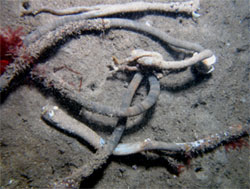
The European fan worm is native to Mediterranean and eastern Atlantic Coast European countries including Spain, Portugal, Italy, France, Turkey and South America. It is commonly found in its native region in shallow subtidal areas and shows a clear preference for sheltered nutrient rich waters.
The European fan worm is a large tube dwelling annelid worm with a crown of feeding tentacles formed in two layers. One layer of tentacles is distinctly spiralled. The feeding tentacles can vary in colour from a uniform dull white to brightly banded with stripes of orange, purple and white.
Adult worms usually range in size from 90-400 mm, with the feeding crown accounting for roughly 45-60 mm of this length. Worms found in deeper water are generally larger. The tube of the worm is made of semi-hardened mucus, which is secreted by the worm as it grows. It is often covered by many small organisms and becomes wrinkled towards the base (NIMPIS 2010).
The European fan worm can be found in temperatures ranging from 2oC to 29oC and individual speciments are thought to live for at least two years. European fan worms are protandric hermaphrodites, starting off as males, and changing to females when they grow larger. Gametes are broadcast into the water column to be fertilised. Large females (greater than 300mm in length) can release more than 50,000 eggs.
In Australia, spawning occurs during the winter months, coinciding with falling water temperatures. Sexual maturity of the invasive European fan worm in Australia is obtained at 50 mm. In Italy (its native region), it is not until the worms are 150 mm long that they are sexually mature. The growth rate of the European fan worm in Australia has been recorded as approximately 15 mm per month during summer in Port Phillip Bay (NIMPIS 2010).
Where are they in NSW?
The European fan worm was first reported in NSW at Snug Cove, Twofold Bay near Eden in November 1996 by the CSIRO. Since this initial discovery, routine surveys have been undertaken by the NSW government in Snug Cove to monitor changes in abundance.
In April 2013, NSW DPIRD received a report, from the Australian Museum, of observations of suspected Sabella spallanzanii in Botany Bay. Australian Museum expertise subsequently confirmed the suspect species to be Sabella spallanzanii. At this time, the Australian Museum collected eight specimens of European fan worm from the area of Inscription Point at Kurnell along the south-eastern shores of Botany Bay (Murray 2013). Follow up surveys undertaken by the Australian Museum did not detect any further specimens.
In response to this discovery, NSW DPIRD developed a strategic sampling program to determine the European fan worm’s distribution and abundance in Botany Bay. Areas targeted included those where surface current modelling indicated that larvae were most likely to accumulate after 10 or 30 days, assuming a release point of either Kurnell (where detected in April), or Port Botany (the primary mooring points for commercial ships in Botany Bay). NSW DPIRD surveys, conducted during July and August 2013, did not detect any European fan worms. While NSW DPIRD surveys were unable to detect further populations of Sabella, the Australian Museum has confirmed through diver surveys during 2014 that specimens of this marine pests species were once again detected at the original location (and subsequently removed by divers). It has since been discovered offshore from Bondi in 2020.
Following an Atlas of Living Australia alert and subsequent positive identification by NSW DPIRD and the Australian Museum, European fan worm has been confirmed in Coogee Baths. This detection is in an area between the two previously confirmed detections in Botany Bay and Bondi.
How did they get here?
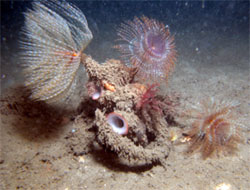
It is not known exactly how the European fan worm was introduced into Twofold Bay or Botany Bay, NSW. There are many vectors that may have been responsible for its translocation, including international shipping or domestic commercial or recreational vessel movements. Marine pests can be translocated as larvae in the ballast water of ships. However, as the larvae of this species are short lived they would not have been capable of surviving long periods of transport in ballast water. It is possible that translocation occurred as a result of the species attaching itself to the hulls of vessels as ‘biofouling’. Another possible vector could include the accidental translocation of species attached to aquaculture gear (ropes, cages, etc).
While the actual vector may never be known, a NSW DPIRD marine pest risk assessment (Glasby & Lobb 2008) ranked the European fan worm as the second most likely new species to be introduced into Botany Bay from a domestic port, with the Port of Melbourne being the most likely source.
What is NSW DPIRD doing?
NSW DPIRD has undertaken surveys in Twofold Bay to monitor European fan worm populations in the years following their first discovery in 1996. European fan worms have been found in two areas of Twofold Bay, Snug Cove and Quarantine Bay; with documented fluctuations in the size of the population over many years, with the number of fan worms in 2013 being similar to that in 2005.
During early surveys, NSW DPIRD removed individual European fan worms. However, as the species has not displayed invasive activity in NSW, no formal eradication or control programs are considered necessary.
NSW DPIRD will continue to monitor populations of European fan worm species by passive surveillance, including alerts from researchers and the community. Report any suspected observations of European fan worms or other marine pest to NSW DPIRD. Any further reported observations or confirmed detections of this species will be investigated and recorded appropriately.
What are the impacts?
There has been little work done on the possible impacts of the European fan worm on marine systems, but it has the potential to compete with native filter-feeding organisms for food and space, and in high densities has the potential to have a negative effect on commercially important species (mussels and oysters). In other states, European fan worms have been observed to grow on mussel ropes, but are not considered by farmers as a significant nuisance.
European fan worms are considered a major threat to benthic assemblages in both hard and soft sediment habitats, and in Port Phillip Bay, Victoria, there is concern on the effect of the European fan worm on nutrient cycling processes, due to their high filtering capacity (12 m3 per day, in Stabilia et al 2006)
The European Fan Worm in New Zealand
The European fan worm was first detected in New Zealand, in Lytellton Port in March 2008, after which a control program was implemented to attempt its eradication. In August 2009 a small population was found in Auckland's Viaduct Basin, and this additional location was also incorporated into the eradication program.
However when widespread populations of European fan worms were found in January 2010 in multiple locations in Waitemata Harbour, the eradication program was stood down as it was determined that eradication of this pest from New Zealand was no longer feasible. This demonstrates the difficulty of eradicating marine pests once they are established, and therefore prevention of these pests in critical to protecting the natural environment.
What can I do to help stop the spread of aquatic pests?
- If you think you have found European fan worms, note its location (take GPS points if possible), take a photo and report it immediately!
- Remain vigilant and report any animal or plant you think is unusual and may be a pest.
- Wash your boat and gear down in wash down bays (where provided) or in an area away from water bodies and stormwater drains. For more information on how to clean your boat to prevent the spread of aquatic pests download the booklet for recreational boaters.
- If you have visited an area known to be infested with an aquatic pest, inspect anchors, ropes and chains before leaving the area and dispose of any unusual plants or animals in a sealed container in a bin.
- Keep your vessel hull clean and free of fouling, don’t let pests hitch-hike to a new location. Maintain antifouling treatments to your vessel hull, if appropriate.
- Do not conduct any hull-scraping in the water. Use a dry dock or other facility where the fouling material can be collected and disposed of properly.
References and further reading
- Murray et.al. 2013 First Report of Sabella spallanzanii (Gmelin, 1791) (Annelida: Polychaeta) from Botany Bay, New South Wales, a northern range extension for the invasive species within Australia: Zootaxa 3670 (3): 394-395
- Australian Museum - Diving for worms
- NIMPIS - Sabella spallanzani
- DAFF Marine Pests - European fan worm
- Stabilia, L., Liccianob, M., Giangrande, A., Fanellia, G. and Cavalloa, R.A. 2006. Sabella spallanzanii filter-feeding on bacterial community: Ecological implications and applications, Marine Environmental Research 61(1): 74-92.
